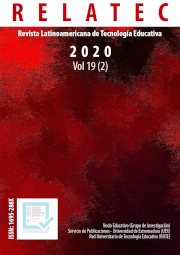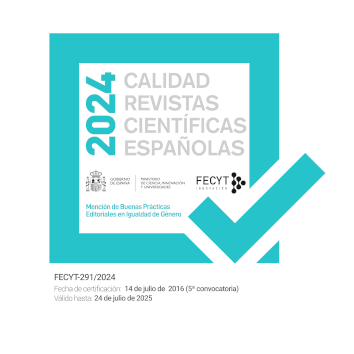Actitudes del profesorado sobre la innovación con herramientas TIC multisensoriales en entornos inclusivos
DOI:
https://doi.org/10.17398/1695-288X.19.2.29Palabras clave:
Actitudes Docentes, Tecnologías Multisensoriales, Aprendizaje Corporeizado, Desarrollo Profesional Docente, Educación InclusivaResumen
Existe evidencia de que el uso de juegos digitales basados en herramientas multisensoriales proporciona beneficios en diferentes dimensiones del aprendizaje del alumnado con necesidades educativas especiales. Sin embargo, el uso de estas herramientas en aulas de infantil y primaria para favorecer la inclusión de dicho alumnado no ha sido tratado en profundidad. El trabajo tiene como objetivo analizar de qué modo la participación de un grupo de docentes en un programa de desarrollo profesional centrado en la integración en el aula de juegos basados en tecnologías multisensoriales, contribuyó a hacer evolucionar sus actitudes sobre la adopción de estas tecnologías en contextos escolares desde una perspectiva inclusiva. En esta investigación se ha empleado un método mixto con estrategia secuencial explicativa. Las técnicas e instrumentos empleados, entrevistas y cuestionarios, nos han permitido recabar datos sobre la evolución de las preocupaciones docentes tras la formación recibida en el marco del Proyecto Europeo INTELed. Los resultados muestran que los docentes otorgaron gran valor a las colaboraciones surgidas en el proyecto, y experimentaron una evolución hacia mayores grados de preocupación en relación con la sostenibilidad y la transferencia de este tipo de innovaciones en el aula.
Descargas
Referencias
Anderson, M.L. (2003). Embodied cognition: a field guide. Artificial Intelligence 149(1), 91-104. https://doi.org/10.1016/S0004-3702(03)00054-7
Anderson, J. L. y Wall, S. D. (2016). Kinecting physics: Conceptualization of motion through visualization and embodiment. Journal of Science Education and Technology, 25(2), 161-173. https://doi.org/10.1007/s10956-015-9582-4
Antle, A. (2013). Research opportunities: Embodied child-computer interaction. International Journal of Child-Computer interaction 1(1), 30-36. https://doi.org/10.1016/j.ijcci.2012.08.001
Balanskat, A., Blamire, R.y Kafal, S. (2007). The ICT impact report. A review of studies of ICT impact on schools in Europe. European Schoolnet. http://portaldoprofessor.mec.gov.br/storage/materiais/0000012853.pdf
British Educational Communications and Technology Agency [BECTA]. (2004). A review of the research literature on barriers to the uptake of ICT by teachers. http://dera.ioe.ac.uk/1603/1/becta_2004_barrierstouptake_litrev.pdf
Bossavit, B. y Pina, A. (2014). Designing educational tools, based on body interaction, for children with special needs who present different motor skills. En International Conference on Interactive Technologies and Games, iTAG 2014, 63–70. doi:10.1109/iTAG.2014.16
Booth, T. y Ainscow. M. (2011). Index for inclusion developing learning and participation in schools. CSIE.
Darling-Hammond, L., Hyler, M. E. y Gardner, M. (2017). Effective Teacher Professional Development. Learning Policy Institute. Recuperado el 24 de noviembre de 2020 de https://learningpolicyinstitute.org/sites/default/files/product-files/Effective_Teacher_Professional_Development_REPORT.pdf
Fugate, J. M. B., Macrine, S. L. y Cipriano, C. (2018). The role of embodied cognition for transforming learning. International Journal of School & Educational Psychology, 7 (4), 274-288. https://doi.org/10.1080/21683603.2018.1443856
Fu, Y., Wu, J., Wu, S., Chai, H. y Xu, Y. (2015). Game system for rehabilitation based on Kinect is effective for mental retardation. En MATEC Web Conference, 22, 1036. DOI: 10.1051/matecconf/20152201036
Georgiou, Y. y Ioannou, A. (2019). Investigating in-service teachers’ concerns about adopting technology-enhanced embodied learning. En: Scheffel M., Broisin J., Pammer-Schindler V., Ioannou A., Schneider J. (eds) Transforming Learning with Meaningful Technologies. EC-TEL 2019. Lecture Notes in Computer Science, vol 11722. Springer.
Georgiou, Y. y Ioannou, A. (2020). A Co-design approach for the development and classroom integration of embodied learning Apps En International Conference on Human-Computer Interaction. (217–229). Springer, Cham.
Greene, J. C., Caracelli, V. J. y Graham, W. F. (1989). Toward a conceptual framework for mixed method evaluation designs. Educational Evaluation and Policy Analysis, 11(3), 255-274.
Hall, G. E., George, A. A. y Rutherford, W. L. (1977). Measuring stages of concern about the innovation: A manual for use of the SoC questionnaire. Southwest Educational Development Laboratory.
Ioannou, M., Ioannou, A., Georgiou, Y. y Retalis, S. (2020). Designing and Orchestrating the Classroom Experience for Technology-Enhanced Embodied Learning. En Gresalfi, M. and Horn, I. S. (Eds.), The Interdisciplinarity of the Learning Sciences, 14th International Conference of the Learning Sciences (ICLS) 2020, Volume 2 (pp. 1079-1086). Nashville,
Tennessee: International Society of the Learning Sciences.
Lawrence, J. E. y Tar, U. A. (2018). Factors that influence teachers’ adoption and integration of ICT in teaching/learning process. Educational Media International, 55(1), 79–105. https://doi.org/10.1080/09523987.2018.1439712
Johnson-Glenberg, M.C., Megowan-Romanowicz, C., Birchfield, D.A. y Savio-Ramos, C. (2016). Effects of embodied learning and digital platform on the retention of physics content: Centripetal force. Frontiers in Psychology 7, 1819. https://doi.org/10.3389/fpsyg.2016.01819,
Kosmas, P., Ioannou, A. y Retalis, S. (2017). Using embodied learning technology to advance motor performance of children with special educational needs and motor impairments. En European Conference on Technology Enhanced Learning (111-124). Springer, Cham. https://doi.org/10.1007/978-3-319-66610-5_
Kosmas, P. y Zaphiris, P. (2018). Embodied cognition and its implications in education: An overview of recent literature. Educational and pedagogical sciences, 12 (7), 970-976. DOI: 10.1999/1307-6892/10009334
Kyza, E. A. y Georgiou, Y. (2014). Developing in-service science teachers' ownership of the profiles pedagogical framework through a technology-supported participatory design approach to professional development. Science Education International 25, (2), 55-77. https://eric.ed.gov/?id=EJ1032967
Mademtzi, M. (2016). The use of a Kinect-based technology within the school environment to enhance sensory-motor skills of children with autism. Tesis doctoral. Universidad de Birmingham.
Martínez-Monés, A., Villagrá-Sobrino, S., Georgiou, Y., Ioannou, A., y Ruiz, M. J. (2019). The INTELed pedagogical framework: Applying embodied digital apps to support special education children in inclusive educational contexts. Proceedings of the XX International Conference on Human Computer Interaction, 1–4. https://doi.org/10.1145/3335595.3335652
Mumtaz, S. (2000). Factors affecting teachers’ use of information and communications technology: a review of the literature. Journal of Information Technology for Teacher Education, 9(3), 319–342. https://doi.org/10.1080/14759390000200096
Penuel, W. R. (2019). Co-design as infrastructuring with attention to power: Building collective capacity for equitable teaching and learning through design-based implementation research. En Collaborative Curriculum Design for Sustainable Innovation and Teacher Learning (pp. 387-401). Springer, Cham.
Rozell, E.J. y Gardner, W.L. (1999). Computer-Related Success and Failure: A Longitudinal Field Study of the Factors Influencing Computer-Related Performance. Computers in Human Behavior, 15(1), 1-10.
Vocht, M., Laherto A. y Parchmann, I. (2017). Exploring teachers’ concerns about bringing responsible research and innovation to European science classrooms. Journal of Sciences Teaching Education. 28, 326–346. https://doi.org/10.1080/1046560X.2017.1343602
Wilson, M. (2002). Six views of embodied cognition. Psychonomic bulletin & review 9(4), 625-636
Descargas
Publicado
Número
Sección
Licencia
Los autores/as que publiquen en esta revista aceptan las siguientes condiciones:
1. Los autores/as conservan los derechos de autor y ceden a la revista el derecho de la primera publicación, con el trabajo registrado con la licencia Creative Commons Reconocimiento-NoComercial-SinObraDerivada 4.0 International (CC BY-NC-ND), que permite a terceros utilizar lo publicado siempre que mencionen la autoría del trabajo y a la primera publicación en esta revista.
2. Los autores/as pueden realizar otros acuerdos contractuales independientes y adicionales para la distribución no exclusiva de la versión del artículo publicado en esta revista (p. ej., incluirlo en un repositorio institucional o publicarlo en un libro) siempre que indiquen claramente que el trabajo se publicó por primera vez en esta revista.
3. Se permite y recomienda a los autores/as a publicar su trabajo en Internet (por ejemplo en páginas institucionales o personales) antes y durante el proceso de revisión y publicación, ya que puede conducir a intercambios productivos y a una mayor y más rápida difusión del trabajo publicado (vea The Effect of Open Access).









